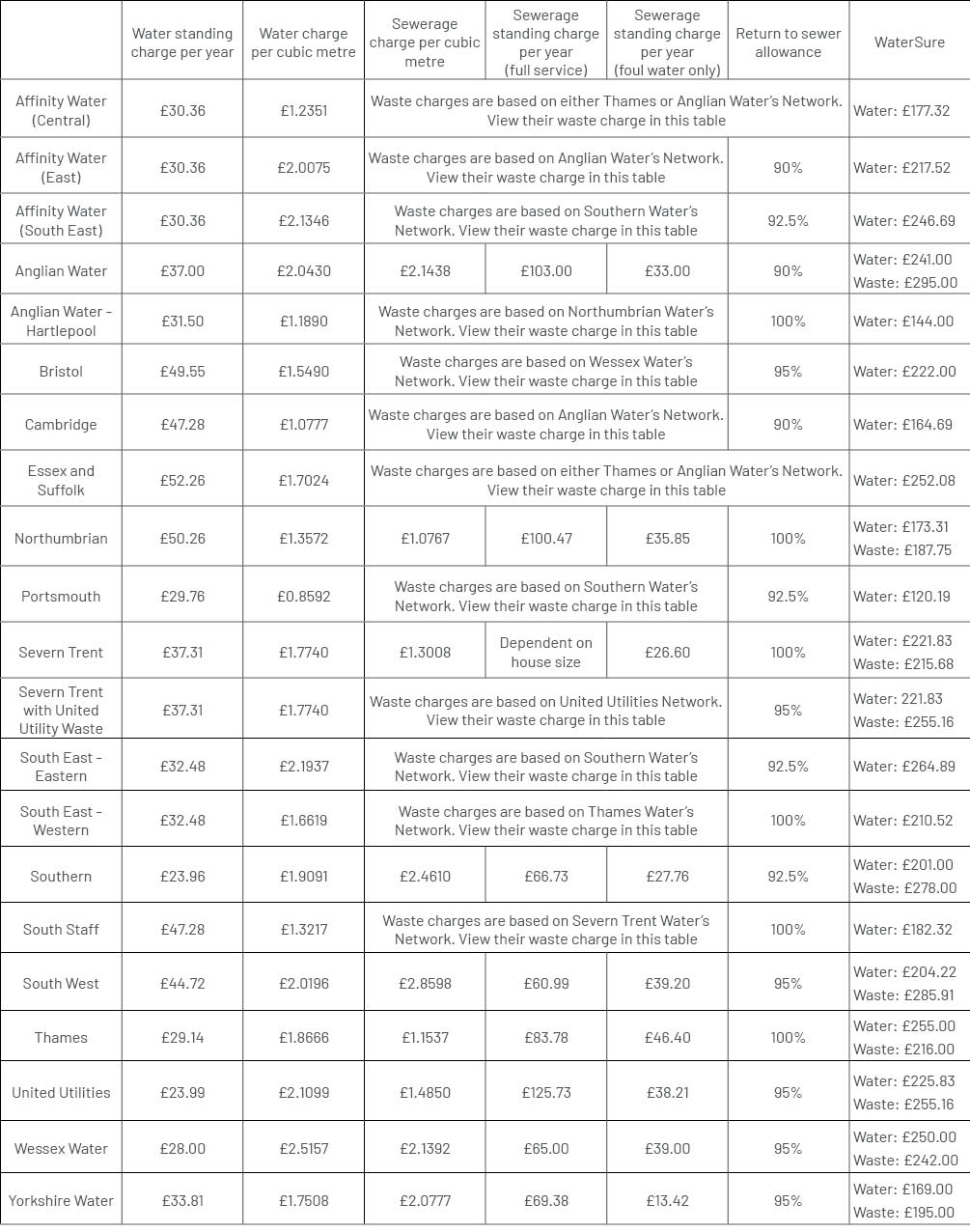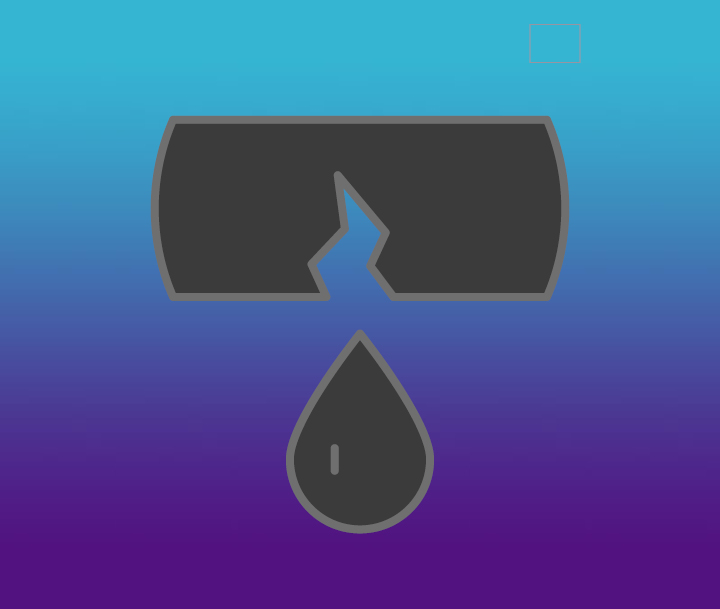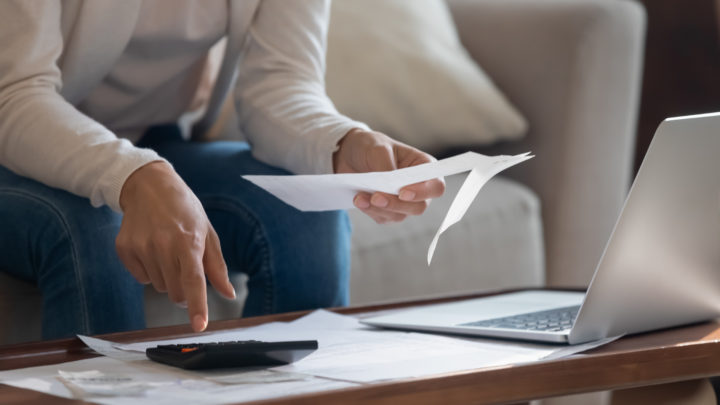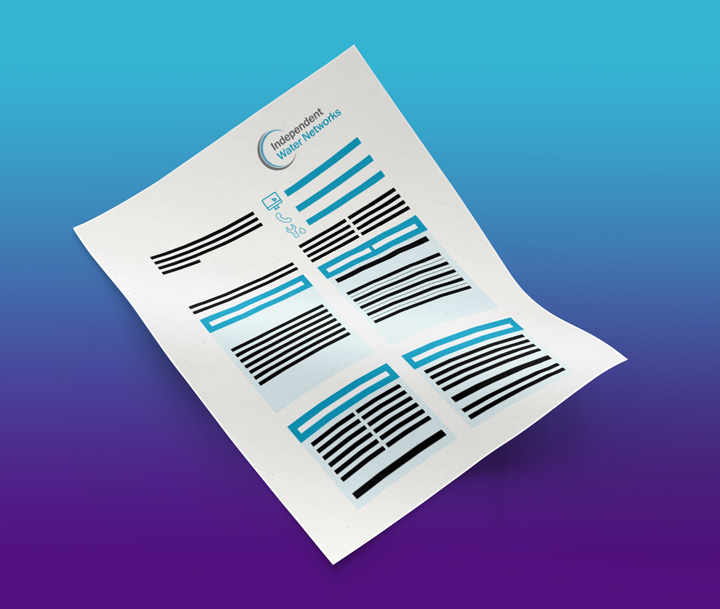Every year we review our water and sewerage charges to make sure you’re getting the best value for your money. Your water charges for the period 1st April to 31st March can be seen in the table below.
You can also view your charges by using our postcode checker.
Being with IWNL means you will not be charged any more than if you were being supplied by a traditional water company. Our prices match, or in some cases are lower than, the local supplier.

2024 – 2025 charges
To ensure our water bills are fair and transparent, our charges for 2024/25 are set by Ofwat (The Water Services Regulation Authority); the economic regulator of the water sector in England and Wales.
The change in how much customers will pay this year is being driven by several factors, including the rate of inflation (using annual CPIH, also known as Consumer Prices Index).
IWNL automatically apply a 2.5% discount to the water consumption part of your bill. These savings will be clearly shown on your bill.

Worried about paying your bills?
We understand sometimes it can be difficult to pay for the household bills. If you’re worried about paying your bills, or think you might need a little extra support, we are here to help.
Click here for more information or call us on 02920028711 and we can discuss a number of ways to help.
What are my water charges?
Find out if IWNL supply your area and compare our charges against other suppliers.
Use the table below to find out the equivalent rates in your local region

To download the full Charges Scheme document for your area for 2024 – 2025, go to the useful documents section on the homeowners page.
Useful Information
IWNL operates in many water company areas. We base our charges on those of the local water company that supplies the area you live in.
All properties supplied by IWNL have a water meter, and you are charged based on the volume of water recorded by your meter.
Your charges include water and sewerage charges based on the volume of water used and the appropriate standing charges.
If the meter records no water use, for example if the property is unoccupied, only the appropriate water and sewerage standing charges will apply. Standing Charges will continue to accrue, and a bill sent out, unless a request is made to disconnect the supply. In this situation, surface water drainage charges may still apply.
We aim to read your meter at least once a year. If we have not been able to read your meter, we will send you an estimated bill based on your average use.
If you receive an estimated bill, you can provide us with the correct meter reading by contacting us or by logging in to your IWNL online account and clicking on the ‘Submit meter reading’ button.
If you suspect that your meter is faulty, you can ask us to test it. If necessary, we will replace it. We will not charge for the test if we find that the meter is faulty. If you disagree with the results of the initial test, you can ask us to remove the meter and send it for independent testing.
If the meter is over-recording, we will adjust charges to reflect the correct level of use, either from the date the meter became faulty or, if this is not known, from six months before the date of the last reading we took. If the meter is under-recording, we will not backdate the charges. We will give you a copy of the meter test report as soon as it becomes available.
If you have any disputes about meter testing, you can request that it is referred to an independent arbitrator, which must be agreed with us.
This charge is calculated using the volume recorded by your water meter since the date of the last reading multiplied by the unit charge.
The water standing charge is calculated on a daily basis and covers the cost of reading and maintaining your meter. This charge is based on our published tariff for this service, unless agreed otherwise for commercial customers.
We assume that most of the water recorded by the meter will end up going into the sewer. Because some will be used for drinking or cooking and therefore not going into the sewer, we calculate sewerage charges based on a percentage of the water recorded by your meter. This percentage will differ from region to region. Check the relevant Charges Scheme for your area.
If you feel that you will use large amounts of water that will not go to the sewer, please contact us to discuss ways in which we can agree a larger discount with you – for example by installing a sub-meter.
You are liable to pay sewerage standing charge if the wastewater from your property drains either directly or indirectly into a public sewer, or benefits from any facilities that drain into a public sewer. This charge is based on our published tariff for this service, unless agreed otherwise for commercial customers.
This charge includes the cost of disposing of rainwater due to surface water and highway drainage. If you think the surface water drainage charge should not apply to your property, i.e. because you have a soakaway or no surface water flows directly or indirectly into the public sewer, please contact us. In the event that your claim is successful, we will give a rebate from the date you moved into the property.
You must notify us immediately if at any time the premises become connected to a public sewer, either directly or through an intermediate sewer or drain, for surface water drainage. Whether or not we are notified, full charges will become payable immediately from the date of connection.
Where your property has received a service and it is subsequently found that you have been undercharged for this service, we may make an adjustment to reflect the current charges for previous years. In the case of surface water drainage, if incorrect bills have been submitted, the adjustment will be limited to the 1st April of the charging year in which the mistake was identified.
We operate a special scheme known as WaterSure that is designed to help reduce bills for vulnerable customers or households in certain circumstances and who need to use large amounts of water.
Find out more about WaterSure here.
Social tariffs are designed to help customers who face difficulty affording to pay their bills. IWNL currently seeks to match social tariffs offered by local incumbent water companies. Please contact us if you would like to discuss help that might be available.
Charges are applicable when a supply of water is made available for your property, regardless of whether or not you use the supply, or if the wastewater from your property drains either directly or indirectly into a public sewer, or it benefits from any facilities that drain into a public sewer. This includes surface water drainage.
You are responsible for paying water, drainage and sewerage charges if:
- You are the occupier of the property
- You have sufficient control over the property to owe a duty of care towards those who come lawfully onto the premises
- You own or maintain property, furnished or otherwise, ready for occupation, letting, sale or commercial use
Charges should always be paid by the occupier of the property unless we agree otherwise. If more than one person lives in the property, any of you can be held liable for the bill even if the bill is not addresses to you. In the case of two premises being supplied by one meter, the occupiers of each of the premises supplied through that meter shall be jointly and severally liable for the whole of the charges calculated based on the volume of water passing through that meter.
If you are moving out of the property, you need to give us at least two working days’ notice. If you do not give us two working days’ notice, you will be liable for charges until whichever of the following occurs first:
- The new occupier contacts us and informs us that they are now responsible for the charges
- The 28th day after we are informed
- The date on which the meter would normally have been read in order to calculate the final bill
When you inform us that you are moving out, you can either give us with a meter reading or allow us to use an estimated meter reading to calculate the final bill.
Where a customer moves out of a property without notifying us and a new customer moves in without notifying us, we will need to take a meter reading in order to calculate the average daily use and use this to calculate the amount owed by the new customer since the date they moved in.
If you are granted an Order for Bankruptcy which encompasses a water and sewerage charge debt, the debt will be limited to the charges outstanding up to the date of the Order for Bankruptcy, included any charges accrued on a daily basis. Any charges that accrue from the day after the Order for Bankruptcy shall be due as if the property had been newly occupied on that day.

Payments
We offer a choice of ways to pay your bills. Find out which method is right for you and when your bill is due.

Complaints
If you have a problem or are unhappy with our service, find out how you can complain.

Leaks
If you have received a large bill as a result of a leak from underground pipework, find out if you're entitled to a leak allowance.

Debt
If you owe us money or miss payments, we will send reminders. Find out more about our debt process.

Help with paying your bills
We understand sometimes it can be difficult to pay for all your household bills. Find out how we can help give you extra support.

Understanding your bill
Utility bills can sometimes be confusing. We have put together a helpful guide so you can see how your water bill is made up.
